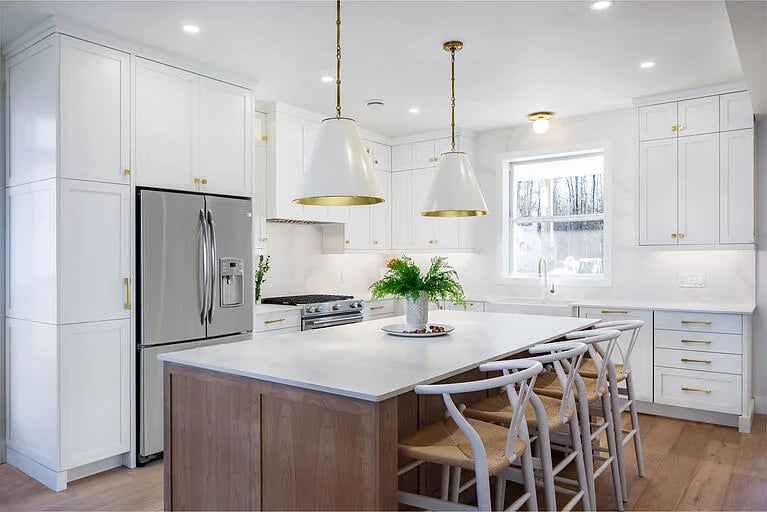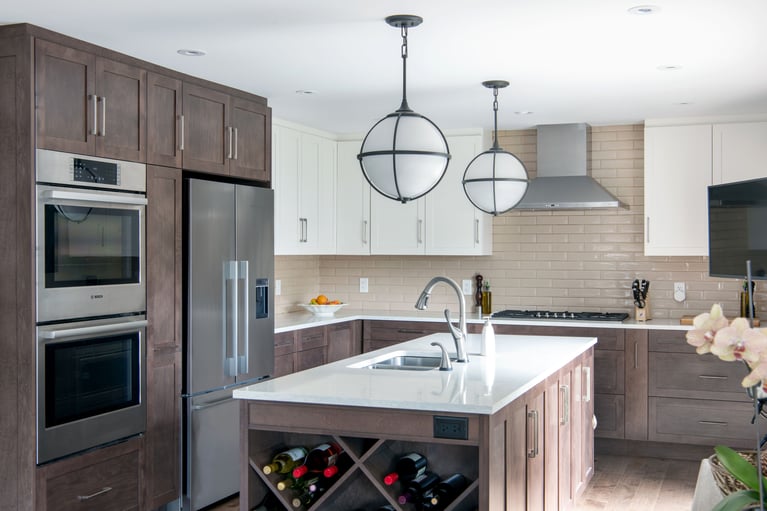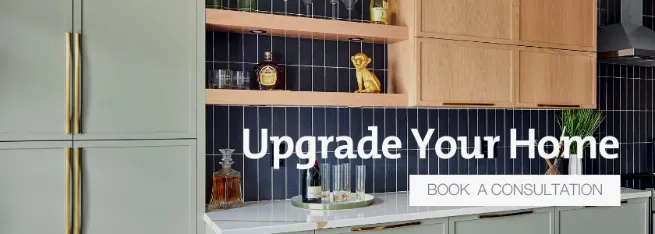Are your cabinets looking dull and faded?
Perhaps they’ve succumbed to general wear and tear and the paint is beginning to chip away. Or maybe you were inspired by something you saw online and want to upgrade your current cabinet doors with a fresh new look.
Repainting or refinishing your cabinet doors is a great way to add an immediate transformation to your kitchen while saving thousands of dollars as an alternative to buying entirely new cabinetry.
The best part is, you don’t need a professional to refinish your cabinets. All it takes is a little time and effort, and you can have your kitchen looking brand new after one weekend of hard work.
If you’re up for the DIY challenge, let’s get started!
| Table of Contents |
 Is This Project Right For Your Cabinets?
Is This Project Right For Your Cabinets?
Refurbishing kitchen cabinet doors may not be for everyone. There are a few things you should consider before continuing with this process.
Do You Have The Space?
This DIY project will require an immense amount of workspace to properly accomplish. You'll need the adequate room to sand and paint your cabinet doors, as well as space for them to properly dry.
If you don't have a garage or expanded workspace, this may not be ideal for you.
Do You Want Different Cabinets?
Maybe you don't want just a new paint colour, but new cabinet doors. Repainting or restaining your cabinets is a great aesthetic upgrade for your kitchen, but it may not be what you need.
For instance, if you want to change your painted cabinets to a stained natural wood, or maybe want a different style of cabinet doors, you'll need to purchase new ones to achieve that. Or if you plan on making design adjustments to your kitchen, or fear your current cabinets are a bit too worn down, you might be better off purchasing entirely new kitchen cabinetry.
If you lack the required workspace, or think you're better suited to purchasing new cabinets, we can help with that! Deslaurier specialized in all things custom cabinetry. Schedule a free consultation with one of our kitchen design experts today, and you'll be on your way to the dream kitchen you've always wanted!
Preparing Your Cabinet Doors
First thing’s first: let’s prepare those cabinet doors for their new finish!
Properly preparing your cabinet doors (regardless of the intended paint, stain or other type of finish) is vital to ensuring your cabinets receive the desired appearance you have set out to achieve.
1. Organize and Label Doors
Before getting started, it’s important to properly organize or label your doors.
This process will only take a few minutes and it is well worth it when the time comes to re-hang your doors.
2. Remove Hardware and Hinges
Next, remove any and all cabinet handles or hinges.
If you have any adjustable hinges, properly label those and place them in their corresponding cabinets. This will save you the unwanted hassle of having to readjust them during the rehanging process.
3. Clean The Cabinet Doors
Once the hardware has been removed, it’s time for cleaning. Thoroughly cleaning your cabinet doors is vital to guaranteeing your cabinets turn out flawless.
You’ll want to scrub the cabinets using a strong degreaser, such as Krud Kutter or Goo Gone.
Apply the degreaser to a kitchen sponge and begin scrubbing your cabinet doors. Use a toothbrush to meticulously clean any grime along the grooves or corners of the door panels.
Make sure the surface is completely scrubbed clean of any dirt or residue before continuing the refinishing process. If not, the finish will not adhere to the cabinet doors as meticulously as you would like.
After degreasing, lightly rinse and wipe the doors and then let them dry.
But why stop at just the doors? Have those hinges and cabinet boxes looking brand new after reading our guide for kitchen cabinet cleaning!
4. Sand The Doors
Once your doors are cleaned, it’s time to sand them. It is in your best interest to wear a mask during this process, so as to not breathe in any dust or fumes.
You do not need to remove all of the paint or stain from the cabinets, just the surface layer of gloss. Removing the gloss will ensure the new paint or stain you apply will produce a clean, smooth surface.
Use an electric sander or sanding block. They will allow you to reach every part of the surface, especially on 5-piece doors, and will establish an evenly sanded surface.
While you can use traditional sanding paper, it almost certainly won’t provide the even, consistent surface of an electric or block sander. It will also be much faster than manual sandpaper and won’t fatigue your arms and hands.
Make sure to sand with the wood grain and not against it. Otherwise, sanding against the wood grain could cause scratches and result in a coarse, rough finish.
After sanding, remove the sanding dust with a vacuum cleaner attachment and microfibre cloth. It’s crucial that all the dust is removed before you begin refinishing your cabinet doors.
5. Prepare Your Workspace
The final step before beginning to finish your cabinet doors is to set up a proper workspace. You’ll need ample room to paint or stain the doors, as well as space to let them dry.
It’s crucial that you have a flat surface to work on your doors. Applying any primer, paint or stain to a vertical door will cause nasty drips (thanks to gravity) and we absolutely do not want that.
A flat, horizontal surface, such as work tables or sawhorses, is perfect for applying your finish, as well as letting your doors dry. The longer you can let the doors lay flat to dry the better.
Is refinishing not for you? Maybe you need entirely new kitchen cabinets. Book a free consultation today!
How to Paint Cabinet Doors

Once your cabinet doors have been properly cleaned and sanded, and your workspace is prepared, the painting process can begin!
Haven't selected a paint yet? Check out our article on the best selling kitchen cabinet paints and stains!
Apply Primer
For a beautiful, uniform painted cabinet, you’ll want to first apply a primer. Priming sanded doors will ensure a professional-grade aesthetic that will allow the paint to be seamlessly administered.
Use a small roller (preferably 4”) to apply the primer onto the broad surface of the door. Use a paint brush or foam craft brush for multi-panel doors to adequately apply the primer to all joints and mouldings. Spread the primer well for a flat, even coat.
Now, let the primer dry in accordance with the label’s instructions.
Let’s Paint!
After letting your primer dry, it’s finally showtime! Grab your vibrant new paint and let’s get started!
You’ll want to apply paint starting from the interior (lowest depth panel) to the exterior (highest piece of the door). This will help prevent any drips or messy brush strokes on the doors.
You don’t want to add too much paint to your roller or brush, otherwise it will run the risk of drips forming or paint accumulating in any joints.
Begin by using your roller to apply paint on any broad surfaced lower door panels.
Next, use your brush to paint the joints and mouldings on the door. You can continue with the brush on the top panels of the door, or use your roller for a smoother application.
Now, let the paint dry according to the instructions on the label. If you intend on painting the inside of the door as well, wait for the paint to finish drying before flipping the door over and continuing.
Once the first application of paint is fully dry, gently administer a second coat of paint. This will ensure the colour, and symmetry of paint distribution, is as rich and as consistent as possible.
Finally, let your painted doors sit for at least one day, in order for the coats of paint to properly “cure.” Otherwise, if you rehang the doors too soon, they could stick to the cabinets and result in the paint peeling.
If your doors have been painted a new colour, during the drying process is a perfect time to paint the cabinet boxes. Cabinet boxes will take drastically less time to paint than the doors, so leaving them to finish while the doors dry is a smart, time-efficient plan.
Once everything is dry...you’re finished!
Just rehang your doors and enjoy your kitchen’s new beautiful, vibrant cabinets!
Stuck deciding between a bright paint colour or a stunning stain finish? Read about the differences in our article on Stained vs. Painted Kitchen Cabinets!
How to Stain Cabinet Doors

If you don’t plan on painting your cabinets, don’t worry! The door preparation for painting or staining your is the same - all that’s different is how you apply your chosen finish.
Staining is a beautiful way to display the grain and unique intricacies of natural wood cabinetry.
Because stains can often have harmful fumes, it’s important to properly ventilate your workspace. Set up fans for proper ventilation, or work in the garage if you can.
If your stain does not state whether it contains non-toxic chemicals, you should move your project outside to ensure the safety of you and your family.
Apply Pre-Stain Wood Conditioner
The key to an evenly stained cabinet is to first apply pre-stain wood conditioner. Pre-stain conditioner helps prevent blotchiness and keeps the finished stain from seeping deep into the freshly-sanded wood.
Apply the pre-stain conditioner with a brush or cloth. The conditioner should remain on the cabinets for roughly 15 minutes (or instructed otherwise on the label). Then, wipe it off with a dry cloth
If you intend to use the or brush for the stain, clean them with paint thinner.
Apply The Stain
Now it’s time to stain!
You should begin staining your cabinets within roughly 2 hours after applying the pre-stain conditioner.
Start by thoroughly stirring your chosen stain. If the stain is not adequately stirred, it could result in an uneven and inconsistent finish.
It’s important to apply lighter coats so you do not produce a stain darker than what you anticipated. It is almost impossible to remove a heavy stain without having to restart the entire refinishing process.
If you want a lighter aesthetic, begin gently applying the stain with a cloth or fine-bristle brush in the same direction as the wood grain. If a darker stain is what you’re after, there’s no need to worry about which direction you apply your stain.
Always ensure the stain has dried before continuing to administer more stain. Once you have reached your desired stain, let it dry overnight.
Add A Varnish
Now that your cabinets have been stained to perfection, it’s time to apply a varnish for a smooth, protective finish. For this, you’ll want to ensure you use a high-quality brush.
Consider using polyurethane. Polyurethane is a varnish that will ensure your newly stained cabinets will stay protected and durable against daily use.
Gently apply a light coat of polyurethane to your doors. It’s important not to overbrush so you do not cause a streaky finish. Let the first coat dry according to the instructions on the polyurethane label. Then, gently apply another coat.
Just like that, you’re done. Now sit back and admire your newly stained cabinets!
Design With Deslaurier
So, who's up for the DIY challenge? After reading this article, you should know whether the refinishing process is right for you and your kitchen.
If it isn't, and new cabinetry is what you're in need of, book a free consultation with one of our Deslaurier kitchen experts in our Ottawa showroom!




